The University of Virginia Hospital: History of Its Beginnings
The Story of Origins
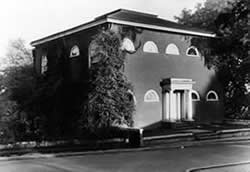
Anatomical Hall, Thomas Jefferson, architect. Designed for anatomical and medical demonstrations, the windows were high so people could not see in. Medical School Professor Robley Dunglison opened a dispensary here. Razed in 1939.
Photo: Historical Collections, Claude Moore Health Sciences Library (CMHSL), University of Virginia (UVa).
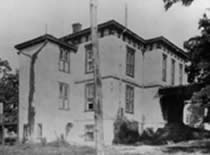
The Infirmary, 1857. Established to provide inpatient medical care for students at the University, under the direction of the medical faculty. This building still stands on the University grounds, near McKim Hall. Photo: Historical Collections, CMHSL, UVa.

Paul Brandon Barringer (1857-1941). Professor of Physiology and Surgery, and Chairman of the Faculty. Photo: Historical Collections, CMHSL, UVa.

The Dispensary, 1892. This building stood on University Avenue near the present George Rogers Clark Memorial. Razed in 1916, the steps at the sidewalk survive. Photo: Historical Collections, CMHSL, UVa.
University of Virginia Hospital
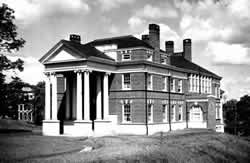
The University of Virginia Hospital, 1901, Paul J. Pelz, architect. Photo: Special Collections, University of Virginia (UVa) Library.
Barringer fostered the idea of establishing a University hospital for the next six years. A faculty committee discussed plans and specifications for the project, and fund-raising efforts began. Architect Paul J. Pelz developed the designs for a 150-bed facility consisting of a central building linked by a single corridor to a pair of flanking pavilions. After intensive planning and negotiation, a construction appropriation became available on October 10, 1899, and on April 13, 1901, Thomas Jefferson’s birthday, the first building of the University of Virginia Hospital opened.

Elevation Drawing, West Facade, University of Virginia Hospital, ca. 1904, Paul J. Pelz, architect. Photo: Special Collections, UVa Library.
In the above drawing, Pelz presented an enlargement of the original scheme for the hospital, expanding the composition to include nine pavilions linked by an enclosed corridor. His intention was to restate in a modern yet complementary architectural language Jefferson’s original conception for the University buildings —the Rotunda, pavilions, and dormitory rooms linked by covered passageways.

The First University of Virginia Hospital as realized, panoramic photograph, ca. 1929. Photo: School of Nursing, Center for Nursing Historical Inquiry, University of Virginia (UVa).
Architect Paul Pelz’s scheme provided a master plan for growth of the complex, but the rapid success of the hospital and the demand for new spaces outstripped the relatively diminutive pavilions he had envisioned. The 1905 and 1907 flanking wings shown above were built with two stories rather than the one originally designed.
In 1916, the Steele Wing was completed (on the far left in the photo above). The largest building to date, the Steele Wing doubled the capacity of the hospital and accommodated in its basement the Outpatient Department formerly housed in the Dispensary. To the right stands the McIntire Wing, completed in 1924, for obstetrical and pediatric services and interns’ quarters. The Teachers’ Preventorium of 1928 is the wing at the far right. Constructed with a payroll deduction from Virginia’s teachers, this facility provided low-cost healthcare for the state’s poorly paid teachers, a valuable service in the era before health insurance.
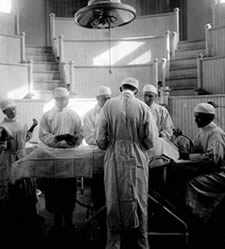
Operating Theater, First Hospital Building, 1913. A photographer from Charlottesville’s Holsinger Studio captured this image of the surgical team. Note the use of ether anesthesia, dripped onto a cloth draped over the patient’s face. Photo: Special Collections, UVa.
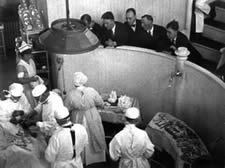
Surgical Observation, Operating Theater, First Hospital Building, ca. 1921. The operating theater was a large room, flooded with natural light and the illumination of a mirrored electric lamp. Students and interns observed from the ascending rows of semi-circular seats. With the opening of the hospital, practical clinical experience was incorporated into the medical degree program. Observation of clinical procedures remains vital to contemporary medical education. Photo: School of Nursing, Center for Nursing Historical Inquiry, UVa.
This first building of the hospital complex contained an operating theater, solarium, laboratories, and accommodations for the superintendent and student nurses. Its total cost was $26,000, about one-quarter over budget. In 1902, beds for 25 patients were installed. Two pavilion wings, added in 1905 and 1907 to each side of the main building, contained large wards for patients, a small number of private rooms, storage and kitchen facilities, and interns’ quarters.
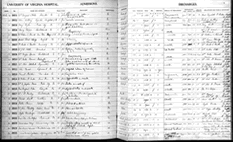
Hospital Admissions Book. Photo: Historical Collections, CMHSL, UVa.
Unlike many hospitals of the day, the University of Virginia Hospital required records on each patient starting in 1907. This photograph shows a page from the first admissions book. It is notable because the second patient listed is Ellen Anthony, who was the second reported case of sickle cell anemia in medical literature. This documents Anthony’s admission on November 15, 1910, and indicates she was diagnosed with “crescentic” anemia and discharged unimproved on April 1, 1911, nearly half a year later.
Nurses and the Early School of Nursing
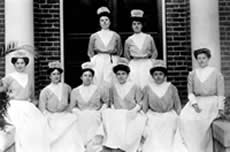
Nursing Students at the Hospital entrance, ca. 1906. Photo: School of Nursing, Center for Nursing Historical Inquiry, UVa.
To ensure adequate staffing of the hospital, the University of Virginia opened a training school for nurses in 1901. Student nurses learned on the job, working ten to twelve hours a day for two years before obtaining their degree. These nurses lived on the premises.
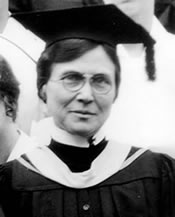
Josephine Sarah McLeod (1880-1948). Photo: School of Nursing, Center for Nursing Historical Inquiry, UVa.
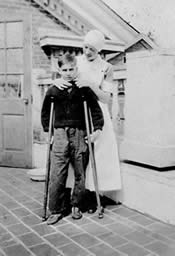
A nurse and boy stand on the bridge leading from the upper floor of the first hospital building to the new medical school. Photo: School of Nursing, Center for Nursing Historical Inquiry, UVa.

Hospital Patients and Personnel of the 1920s. Photo: School of Nursing, Center for Nursing Historical Inquiry, UVa.
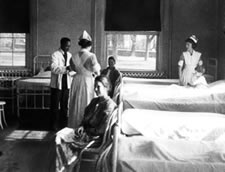
Steele Wing Ward, ca. 1921. Photo: School of Nursing, Center for Nursing Historical Inquiry, UVa.
Previous: The UVa Hospital Celebrating 100 Years
Next: History of the UVa Hospital in the Early 20th Century